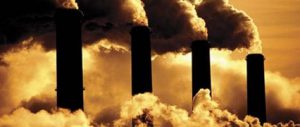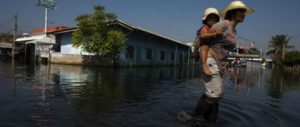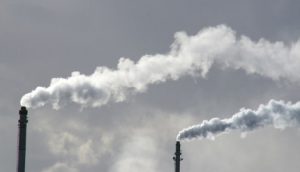Read also: Technology was the key factor in saving the ozone layer
Climate change is not our first planetary pollution crisis. Almost 40 years ago, scientists discovered that chemicals called chlorofluorocarbons (CFCs) were destroying the fragile ozone layer that protects us from the sun’s dangerous ultraviolet radiation.
If we had failed to protect the ozone layer, hundreds of millions of people around the world would be condemned to suffer dreadful diseases, including skin cancer, eye cataracts and immune system disorders. And we would be enduring devastating disruption of world food production, especially in the developing world.
But the world came together and averted a catastrophe. The crowning moment came in 1990, when developed and developing nations joined together to form the first truly global treaty to protect our shared atmosphere. Formally known as the “London Amendments to the Montreal Protocol”, this landmark agreement brought in all nations, under fair and equitable terms, to phase out the production of CFCs, rescue the ozone layer and save millions of lives.
As we struggle for agreement on steps to curb the carbon pollution that’s driving climate change, it’s worth remembering, and learning from, our success in solving the ozone crisis.
Phasing out CFCs
The road to the London agreement began in 1974 when two chemists, Sherwood Rowland and Mario Molina, discovered that CFCs released from aerosol sprays could rise miles into the stratosphere. There the sun’s harsh rays split the CFCs apart, triggering chemical reactions that destroyed ozone molecules. As the ozone shield weakened, more of the sun’s dangerous UV rays would reach the earth’s surface.
Although their discovery later earned Rowland and Molina the Nobel Prize in chemistry, at first they received a mixed reaction. On the one hand, millions of consumers in industrial nations stopped using CFC aerosol sprays, and sales of those products tumbled. But the big companies that made those chemicals scoffed at the risks. CFC use kept growing in other products, like refrigerators and air conditioners. By the mid-1980s, CFC production was back to its 1974 peak and rising fast. The danger to the ozone layer was growing again.
The surprise discovery of a gaping hole in the ozone over Antarctica added new urgency. By 1986, even the chemical industry acknowledged CFC limits were needed and alternatives were available.
In 1986, an environmental organisation called the Natural Resources Defense Council (NRDC) – where I work today – proposed the idea of a 10-year global phase-out of CFCs. Let’s start using available alternatives immediately, NRDC proposed, and let’s create incentives to perfect and deploy solutions for the remaining uses. And let’s do this in all the countries that make and use these chemicals.
Three decades ago, the production of CFCs was concentrated in the United States, Europe and Japan, although developing countries took part in treaty talks from the start. In 1987, spurred on by predictions of millions of skin cancers, 46 countries reached agreement on the Montreal Protocol. They agreed that industrial countries would act first by cutting CFC production in half over a decade. Developing countries would have an additional 10 years.
Just a few months after the Montreal agreement was reached, scientists found the “smoking gun” that tied CFCs to the Antarctic ozone hole. The original Montreal signatories knew that more needed to be done.
So in 1990 they strengthened the original agreement with a three-part plan that reflects the principle of common but differentiated responsibilities.
First, developed countries agreed to move faster, by completely eliminating CFCs in the 1990s.
Second, developing countries, including China and India, agreed that they would also completely eliminate CFCs 10 years later.
Third, the developed countries agreed to contribute to a Multilateral Fund to help developing countries with the costs of transitioning to safer alternatives.
This three-part plan has stood the test of time. Every country on earth, from China to South Sudan, is now a full party to the Montreal Protocol. In subsequent accords, the Montreal parties have repeatedly agreed to curb more chemicals, to speed up the phase-out schedules, and to sustain the Multilateral Fund. Chinese enterprises have received more than a billion dollars in technology transition assistance from the multilateral fund – more than a third of the total.
Read also: There is no plan B for the climate
It is not easy to convey the scale of the catastrophe that was avoided, the disaster that did not happen. Millions of lives saved. Hundreds of millions of cancers averted. Agricultural disasters avoided. This is what NASA scientist Dr Paul A. Newman calls “The World Avoided”. You can read about it on NASA’s website, and you can watch Dr Newman explain it here.
So what are the lessons we’ve learned?
First, by acting together, nations have put the ozone layer on the road to recovery. Countries didn’t stop with eliminating CFCs. They also agreed to phase out other ozone-depleting chemicals, including chemicals called hydrochlorofluorocarbons (HCFCs), over the coming decades. If we stick with it, scientists expect the Antarctic ozone hole to close for good around mid-century.
Second, the Montreal treaty has provided the world with a huge climate change bonus. CFCs and HCFCs also are powerful heat-trapping pollutants, and replacing them has slowed climate change by a decade. Had we not acted, the world would already be suffering even more severe heat waves, droughts, floods and storms. This year’s weather extremes would have been even worse.
But we have also learned that another group of CFC replacements, called hydrofluorocarbons (HFCs), poses a big problem. HFCs are also powerful greenhouse gases, and scientists estimate that if we let them keep growing, by mid-century they’ll trap as much heat as CFCs did at their peak.
So some countries, ranging from the vulnerable island nation of Micronesia to Mexico, Canada, and the United States, have proposed to gradually phase down HFCs under the Montreal treaty. They argue that the Montreal parties have a responsibility to ensure that replacement chemicals are safe – and that includes ensuring that they don’t worsen climate change.
China blocking negotiation on HFCs
The vast majority of countries – both developed and developing – want to move forward on HFCs, provided they can negotiate the right timetables and funding. But China, joined by India and Brazil, has so far blocked the start of negotiations.
China has argued that HFCs have to be dealt with under the climate-change treaties. China also contends that developed countries should act first and come back to developing countries later. But many observers think that’s a recipe for stalemate. The main questions in the climate treaty talks concern carbon dioxide and energy. Those talks won’t get to the other climate-changing pollutants, like HFCs, for a long time.
And the world has changed over the last 25 years. Back then, almost all the CFC production was in the developed nations, and it made sense to demand that they clean up their own house before asking developing nations to pitch in. The story is different for HFCs. China is already an important HFC producer. If present trends continue, the vast majority of HFCs will be produced and used in China and other developing countries.
Read also: Technology was the key factor in saving the ozone layer
China is right that all countries need to do much more to meet the threat of climate change under the climate treaties. But we shouldn’t pass up the chance also to make progress under the Montreal Protocol, which has a proven track record in dealing with the industries that make and use this family of chemicals.
China can lead again to achieve a fair and equitable global deal, one that rewards the leaders, including enterprises in China and India, that are beginning to produce climate-friendly HFC replacements and the equipment that uses them. And by contributing to a breakthrough on HFCs under the treaty with the world’s best track record, China will help build the trust and confidence we need to break through the logjam in the climate talks.
I am confident we can succeed. The Montreal Protocol is proof positive that the earth’s nearly 200 countries can cooperate to save their citizens from a planetary pollution catastrophe.
If we can protect the ozone layer, we can find a way to protect the climate.
David Doniger is policy director of the climate and clean air program at the Natural Resources Defense Council. NRDC is an international environmental organisation with offices and activities in the United States, China, India and many other nations.




